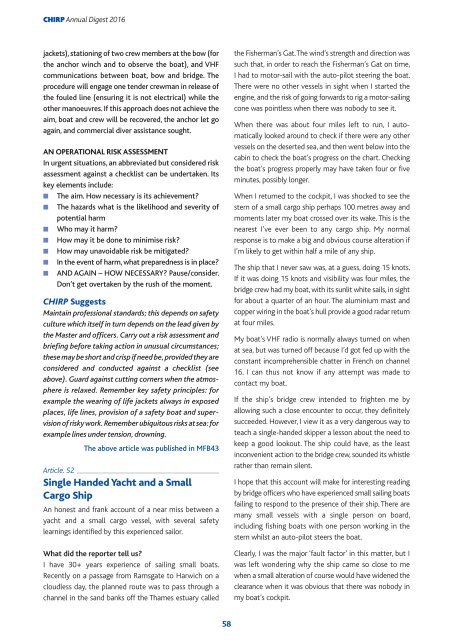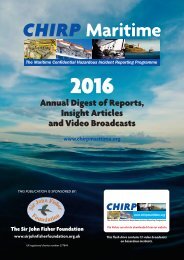CHIRP annual digest 2016 6th
You also want an ePaper? Increase the reach of your titles
YUMPU automatically turns print PDFs into web optimized ePapers that Google loves.
<strong>CHIRP</strong> Annual Digest <strong>2016</strong><br />
jackets), stationing of two crew members at the bow (for<br />
the anchor winch and to observe the boat), and VHF<br />
communications between boat, bow and bridge. The<br />
procedure will engage one tender crewman in release of<br />
the fouled line (ensuring it is not electrical) while the<br />
other manoeuvres. If this approach does not achieve the<br />
aim, boat and crew will be recovered, the anchor let go<br />
again, and commercial diver assistance sought.<br />
AN OPERATIONAL RISK ASSESSMENT<br />
In urgent situations, an abbreviated but considered risk<br />
assessment against a checklist can be undertaken. Its<br />
key elements include:<br />
■ The aim. How necessary is its achievement?<br />
■ The hazards what is the likelihood and severity of<br />
potential harm<br />
■ Who may it harm?<br />
■ How may it be done to minimise risk?<br />
■ How may unavoidable risk be mitigated?<br />
■ In the event of harm, what preparedness is in place?<br />
■ AND AGAIN – HOW NECESSARY? Pause/consider.<br />
Don’t get overtaken by the rush of the moment.<br />
<strong>CHIRP</strong> Suggests<br />
Maintain professional standards; this depends on safety<br />
culture which itself in turn depends on the lead given by<br />
the Master and officers. Carry out a risk assessment and<br />
briefing before taking action in unusual circumstances;<br />
these may be short and crisp if need be, provided they are<br />
considered and conducted against a checklist (see<br />
above). Guard against cutting corners when the atmos -<br />
phere is relaxed. Remember key safety principles: for<br />
example the wearing of life jackets always in exposed<br />
places, life lines, provision of a safety boat and super -<br />
vision of risky work. Remember ubiquitous risks at sea: for<br />
example lines under tension, drowning.<br />
The above article was published in MFB43<br />
Article. 52<br />
Single Handed Yacht and a Small<br />
Cargo Ship<br />
An honest and frank account of a near miss between a<br />
yacht and a small cargo vessel, with several safety<br />
learnings identified by this experienced sailor.<br />
What did the reporter tell us?<br />
I have 30+ years experience of sailing small boats.<br />
Recently on a passage from Ramsgate to Harwich on a<br />
cloudless day, the planned route was to pass through a<br />
channel in the sand banks off the Thames estuary called<br />
the Fisherman’s Gat. The wind’s strength and direction was<br />
such that, in order to reach the Fisherman’s Gat on time,<br />
I had to motor-sail with the auto-pilot steering the boat.<br />
There were no other vessels in sight when I started the<br />
engine, and the risk of going forwards to rig a motor-sailing<br />
cone was pointless when there was nobody to see it.<br />
When there was about four miles left to run, I auto -<br />
matically looked around to check if there were any other<br />
vessels on the deserted sea, and then went below into the<br />
cabin to check the boat’s progress on the chart. Checking<br />
the boat’s progress properly may have taken four or five<br />
minutes, possibly longer.<br />
When I returned to the cockpit, I was shocked to see the<br />
stern of a small cargo ship perhaps 100 metres away and<br />
moments later my boat crossed over its wake. This is the<br />
nearest I’ve ever been to any cargo ship. My normal<br />
response is to make a big and obvious course alteration if<br />
I’m likely to get within half a mile of any ship.<br />
The ship that I never saw was, at a guess, doing 15 knots.<br />
If it was doing 15 knots and visibility was four miles, the<br />
bridge crew had my boat, with its sunlit white sails, in sight<br />
for about a quarter of an hour. The aluminium mast and<br />
copper wiring in the boat’s hull provide a good radar return<br />
at four miles.<br />
My boat’s VHF radio is normally always turned on when<br />
at sea, but was turned off because I’d got fed up with the<br />
constant incomprehensible chatter in French on channel<br />
16. I can thus not know if any attempt was made to<br />
contact my boat.<br />
If the ship’s bridge crew intended to frighten me by<br />
allowing such a close encounter to occur, they definitely<br />
succeeded. However, I view it as a very dangerous way to<br />
teach a single-handed skipper a lesson about the need to<br />
keep a good lookout. The ship could have, as the least<br />
inconvenient action to the bridge crew, sounded its whistle<br />
rather than remain silent.<br />
I hope that this account will make for interesting reading<br />
by bridge officers who have experienced small sailing boats<br />
failing to respond to the presence of their ship. There are<br />
many small vessels with a single person on board,<br />
including fishing boats with one person working in the<br />
stern whilst an auto-pilot steers the boat.<br />
Clearly, I was the major ‘fault factor’ in this matter, but I<br />
was left wondering why the ship came so close to me<br />
when a small alteration of course would have widened the<br />
clearance when it was obvious that there was nobody in<br />
my boat’s cockpit.<br />
58



